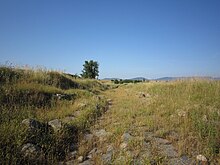Gabii
Gabii was an ancient city of Latium, located 18 km (11 mi) due east of Rome along the Via Praenestina, which was in early times known as the Via Gabina.
A municipium in Roman times, Gabii is currently located in the frazione of Osteria dell'Osa 10 km (6.2 mi) from the comune of Monte Compatri, of which it is a part, in the Province of Rome, Region of Lazio.
[7] Lake Regillus varied in size and depth over the centuries but was certainly between the Via Labicana and the Via Praenestina east of Finocchio and north of Colonna (ancient Labicum), the last remnant at Pantana Borghese having been drained by the Borghese family in conjunction with the restitution of the first part of the Acqua Alexandrina as the Acqua Felice under Pope Sixtus V in the years 1585–1587.
During the thousand years of the post-classical period a much smaller Rome (totally abandoned at one point under the Goths) had lived on a greatly reduced water supply due to the broken and unrepaired aqueducts.
Scattered surface pottery has been found from the Middle Bronze Age outside the necropolis located below Castiglione, from which nothing can be deduced concerning the settlement at Gabii.
The Final Bronze Age is represented by minimal Latial I (1000-900 BC) material around the inside of the crater on the southern side, indicating low-density settlement at the water's edge there.
The location of the settlements producing these cemeteries was an issue of some mystery until aerial reconnaissance revealed a string of six "Iron Age hamlets" on the isthmus and more along the ridge to the east.
[10] Latial IIA is regarded as pre-urban and IIB as proto-urban; that is, at some time during 830-730 BC the settlements acquired a common geopolitical identity.
The tombs are divided into 14 groups, each exhibiting a set of distinctive traditions and each believed to represent one community of roughly 100 persons, round numbers.
The earliest two, contemporaneous and dated to IIA, termed the northern and southern groups from their location within the cemetery, evidence the presence of a male warrior class.
[11] The northern group (25 tombs) covered the mouth of the burial jar (dolium) with a travertine slab, made ovicaprine food offerings, left serpentine fibulae, razors of quadrangular shape and spearheads with sockets for wooden handles.
The southern group (30 tombs) used an impasto lid on the burial jars, left serpent-fibulae of a different-style, a razor of lunate shape and one-piece cast spears.
Plutarch[17] relates the legend that Romulus and Remus were raised by Faustulus, the servant of Amulius, in Gabii, where they learned everything from literature to the use of Greek weapons.
Addressing their council and claiming that, because all the Latin cities were founded from Alba Longa and Tullus Hostilius had made a treaty by which Alba was ceded to Rome along with all its colonies, Rome had a legal claim over the Latins, he offered them protection from any chance devastation that should inflict their country and a share in Roman prosperity if they would resume the treaty, which they did.
Receiving the messenger in the garden the king said nothing at all (for which he might have been held liable later) but strolled around lopping off the heads of the tallest poppies with a stick.
[24] After the overthrow of the Roman monarchy, Sextus fled to Gabii but was killed by the leaders of the city in revenge for his past actions.
Its baths were well known,[26] and Hadrian, who was responsible for much of the renewed prosperity of the small towns of Latium, appears to have been a very liberal patron, building a senate-house (Curia Aelia Augusta) and an aqueduct.
[1][32] The most conspicuous ruin remaining at the site of Gabii is a temple, generally attributed to Juno, which had six Ionic or Corinthian columns in the front and six on each side, excluding the back.
Around the rear of the temple (on the cliff side), which faced and towered above the road, were about 55 pits for planting trees representing a sacred grove.
In the 4th century BC a small shrine was constructed next to the grove around and in connection with which caches of anatomical terra cotta statuettes were found.
[28] Hamilton discovered a large cache of statues that were initially placed in the Borghese collection, although many of them subsequently were carried off to Paris by Napoleon, and still remain in the Louvre.
The statues and busts are especially numerous and interesting (38 in all); besides the deities Venus, Diana, Nemesis, etc., they comprise Agrippa, Tiberius, Germanicus, Caligula, Claudius, Nero, Trajan and Plotina, Hadrian and Sabina, Marcus Aurelius, Septimius Severus, Geta, Gordian III and others.
Other work at the site has been carried out by Stefano Musco, the local inspector of the Soprintendenza Speciale per i Beni Archeologici di Roma (SSBAR).
[34] In early 2007 the multi-institution Gabii Project,[35] led by Nicola Terrenato of the University of Michigan, Ann Arbor, was launched.
[37] In late March 2010 the Gabii Project reported [1] the discovery, in July 2009, of a half-ton lead encased inhumation burial that has tentatively been dated to the Roman Imperial period, likely the second or third centuries A.D.[38] Evidence for early elite burials, in this case those of infants, also emerged in 2009, suggesting the development of social hierarchy in the eighth through sixth centuries BC.
[40][41] The excavations of the Gabii Project continued in 2010 and 2011,[37] during which time substantial portions of several ancient city blocks were brought to light.





